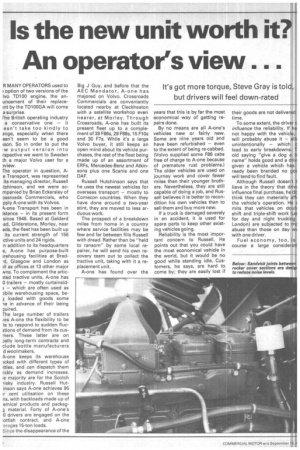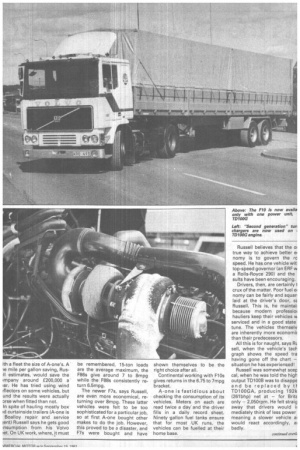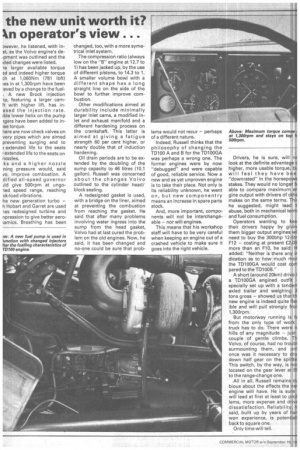Is the new unit worth it?
Page 62

Page 63

Page 64

If you've noticed an error in this article please click here to report it so we can fix it.
An operator's view . . .
It's got more torque, Steve Gray is told, but drivers will feel down-rated
R MANY OPERATORS used to ) option of two versions of the Ivo TD100 engine, the anuncement of their replaceInt by the TD1000A will come a surprise.
rhe British operating industry a conservative one — it esn't take too kindly to ange, especially when there esn't seem to be a good ison. So in order to put the output version into rspective we went to Sweden th a major Volvo user for a view.
['he operator in question, Ae Transport, was represented its managing director, Russell Itchinson, and we were acmpanied by Briar) Eckersley of Dssroads Commercials, who pply A-one with its Volvos.
4-one Transport has been in istence — in its present form since 1948. Based at Gelderd Gilderstone, Morley, near eds, the fleet has been built up its current strength of 156 ctive units and 24 rigids.
n addition to its headquarters e, A-one has purpose-built rehousing facilities at BradA, Glasgow and London as )11 as offices at 13 other major Nns. To complement the articded tractive units, A-one has 0 trailers — mostly curtainsid
which are often used as Dbile warehousing space, be loaded with goods some -le in advance of their being i red.
The large number of trailers /es A-one the flexibility to be le to respond to sudden flucations of demand from its cus-ners. These latter are on Dstly long-term contracts and dude bottle manufacturers d woolmakers.
A-one keeps its warehouse )ckecl with different types of 'Wes, and can dispatch them [ickly as demand increases. le majority are for the Scotch lisky industry. Russell Hutinson says A-one achieves 95 ,r cent utilisation on these ns, with backloads made up of emical products and packagg material. Forty of A-one's
drivers are engaged on the :ottish contract, and A-one erages 15-ton loads.
Since the disappearance of the Big J Guy, and before that the AEC Mandator, A-one has majored on Volvo. Crossroads Commercials are conveniently located nearby at Cleckheaton with a satellite workshop even nearer, at Morley. Through Crossroads, A-one has built its present fleet up to a complement of 39 F86s, 29 F88s, 15 Fl Os and 30 F7s. While it's a large Volvo buyer, it still keeps an open mind about its vehicle purchases, the rest of the fleet being made up of an assortment of ERFs, Mercedes-Benz and Atkinsons plus one Scania and one DAF.
Russell Hutchinson says that he uses the newest vehicles for overseas transport — mostly to Comecon countries. When they have done around a two-year stint, they are moved to less arduous work.
The prospect of a breakdown miles from home in a country where service facilities may be few and far between fills Russell with dread. Rather than be "held to ransom" by some local repairer, he will send his own recovery team out to collect the tractive unit, taking with it a replacement unit. .
A-one has found over the years that this is by far the most economical way of getting repairs done.
By no means are all A-one's vehicles new or fairly new. Some are nine years old and have been refurbished — even to the extent of being re-cabbed. (Volvo supplied some F86 cabs free of charge to A-one because of premature rust problems.) The older vehicles are used on journey work and cover fewer miles than their younger brothers. Nevertheless, they are still capable of doing a job, and Russell believes it is better to recondition his own vehicles than to sell them and buy more new.
If a truck is damaged severely in an accident, it is used for spare parts to keep other existing vehicles going.
Reliability is the most important concern to Russell. He points out that you could have the most economical vehicle in the world, but it would be no good while standing idle. Customers, he says, are hard to come by; they are easily lost if their goods are not deliver time.
To some extent, the driver influence the reliability. If h not happy with the vehicle, will probably abuse it — al unintentionally — which lead to early breakdowns. old saying "give a dog a name" holds good and a dri given a vehicle which has ready been branded no g will tend to find fault.
Although Russell doesn't .1 lieve in the theory that dri influence final purchase, he think they can materially a the vehicle's operation. HO 4 mits that vehicles on dou shift and triple-shift work flu for day and night trucki London) are subjected to abuse than those on day with one driver.
Fuel economy, too, course a large considertil
ith a fleet the size of A-one's. A le mile per gallon saving. Rus11 estimates, would save the impany around 1E200,000 a iar. He has tried using wind iflectors on some vehicles, but und the results were actually Drse when fitted than not.
In spite of hauling mostly box curtainside trailers (A-one is Boalloy repair and service lent) Russell says he gets good Insumption from his Volvo :et. On UK work, where, it must be remembered, 15-ton loads are the average maximum, the F86s give around 7 to 8mpg while the F88s consistently return 6.5mpg.
The newer F7s, says Russell, are even more economical, returning over 8mpg. These latter vehicles were felt to be too sophisticated for a particular job, so at first A-one bought other makes to do the job. However, this proved to be a disaster, and F7s were bought and have shown themselves to be the right choice after all.
Continental working with F1Os gives returns in the 6.75 to 7mpg bracket.
A-one is fastidious about checking the consumption of its vehicles. Meters on each are read twice a day and the driver fills in a daily record sheet, Ninety 'gallon fuel tanks ensure that for most UK runs, the vehicles can be fuelled at their home base. Russell believes that the oi true way to achieve better el nomy is to govern the rc speed. He has one vehicle witl top-speed governor (an ERF w a Rolls-Royce 2901 and the sults have been encouraging.
Drivers, then, are certainly 1 crux of the matter. Poor fuel ei nomy can be fairly and squat-, laid at the driver's door, st' Russell. This is, he maintail because modern professioi hauliers keep their vehicles w serviced and in a good state tune. The vehicles themselv are inherently more economic than their predecessors.
All this is for naught, says sell, when the vehicle's tach graph shows the speed tra having gone off the chart — situation he has experienced!
Russell was somewhat scep cal, when he was told the high output TD10013 was to disappc and be replaced by t1 TD100GA, producing 192k (261 bhp) net at — for BritE only -2,050rpm. He felt straig away that drivers would mediately think of less power meaning a slower vehicle ai would react accordingly, al badly. Dwever, he listened, with inst, as the Volvo engine's depment was outlined and the iiled changes were listed.
le larger available torque .ed and indeed higher torque ch at 1,060Nrn (781 1bn) ies in at 1,300rpm have been eyed by a change to the fuel. A new Brock injection tp, featuring a larger camft with higher lift, has inased the injection rate. ible lower helix on the pump igers have been added to inIse torque.
nere are now check valves on very pipes which are aimed preventing surging and to .1 extended life to the seats ! extended life to the seats on nozzles.
ks and a higher nozzle fling pressure would, said op, improve combustion. A dified all-speed governor ild give 500rpm at ungoled speed range, reaching ck-load vibrations.
he new generation turbo — h Hobart and Garret are used as redesigned turbine and npression to give better aeroiamics. Breathing has been changed, too, with a more symetrical inlet system.
The compression ratio (always low on the "B" engine at 12.7 to 1) has been jacked up, by the use of different pistons, to 14.3 to 1. A smaller volume bowl with a different shape has a long straight line on the side of the bowl to further improve combustion.
Other modifications aimed at durability include minimally larger inlet cams, a modified inlet and exhaust manifold and a different hardening process on the crankshaft. This latter is aimed at giving a fatigue strength 60 per cent higher, or nearly double that of induction hardening.
Oil drain periods are to be extended by the doubling of the sump capacity to 46 litres (10.1 gallon). Russell was concerned about the changes Volvo outlined to the cylinder head/ block sealing.
A redesigned gasket is used, with a bridge on the liner, aimed at preventing the combustion from reaching the gasket. He said that after many problems involving water ingress into the sump from the head gasket, Volvo had at last cured the problem on the old engines. Now, he said, it has been changed and no-one could be sure that prob
lems would not recur — perhaps of a different nature.
Indeed, Russell thinks that the philosophy of changing the TD100 A and B for the TD1OOGA was perhaps a wrong one. The former engines were by now "debugged" and were capable of good, reliable service. Now a new and as yet unproven engine is to take their place. Not only is its reliability unknown, he went on, but new componentry means an increase in spare parts stock.
And, more important, components will not be interchangeable — nor will engines.
This means that his workshop staff will have to be very careful when keeping an engine out of a crashed vehicle to make sure it goes into the right vehicle.
Drivers, he is sure, will nc look at the definite advantage c higher, more usable torque, IA will feel they have bee "down rated" in the horsepow€ stakes. They would no longer b able to compare maximum or gine output with drivers of othE makes on the same terms. Thj he suggested, might lead,. abuse, both in mechanical t and fuel consumption.
Operators wanting to ke their drivers happy by givin them bigger output engines wi need to buy the 300bhp F12 — costing at present £2,00 more than an F10, he said. H added: "Neither is there any ir dication as to how much mor the TD100GA would cost conr pared to the TD1006."
A short (around 20km) drive i a TD100GA engined outfit specially set up with a tanderr axled trailer and weighing 3 tons gross — showed us that th new engine is indeed quite fle) ible and will pull strongly fror 1,30Orpm.
But motorway running is ft from the only type of work truck has to do. There were n hills of any magnitude — just couple of gentle climbs. Th Volvo, of course, had no troull surmounting them, and onl once was it necessary to dro down half gear on the splitte This switch, by the way, is no located on the gear lever at 9( to the range-change one.
All in all, Russell remains di. bious about the effects the ne% engine will have. He is sure will lead at first at least to prot lems, more expense and cirivE dissatisfaction. Reliability, h said, built up by years of ham won experience, is potentiall back to square one.
Only time will tell.








































































